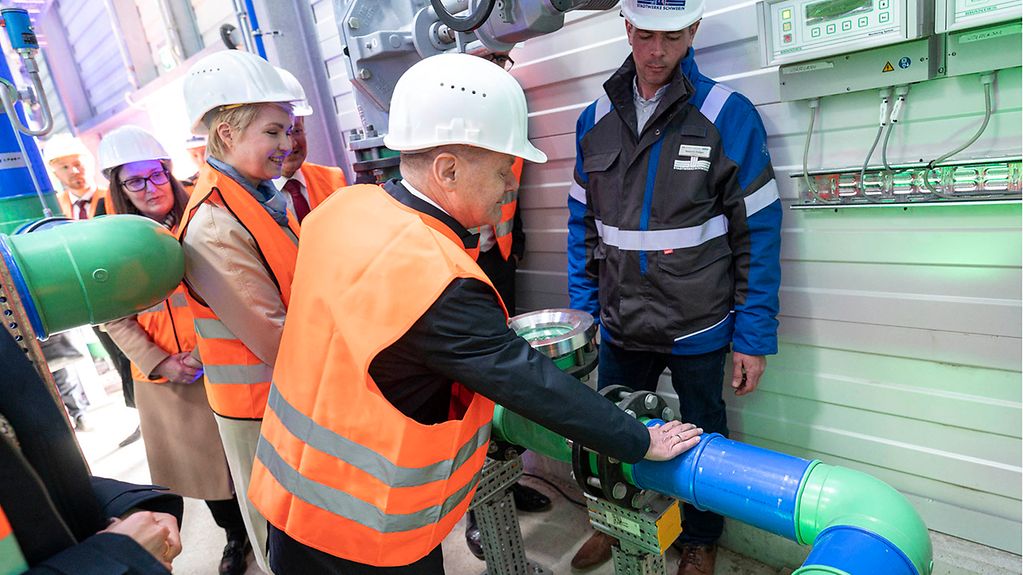The heating transition
Households in Schwerin will in future be supplied with reliable and affordable heat from a depth of 1,300m. On a visit to the city, Federal Chancellor Scholz brought a deep geothermal energy facility on stream. The aim is for the project to be the first of many.
4 Min. Lesedauer

An inexhaustible source of energy: Federal Chancellor Scholz at the opening of the deep geothermal plant in Schwerin.
Foto: Bundesregierung/Bergmann
In future, there is to be greater diversity in how heating and energy are supplied in Germany. The key to achieving climate goals is renewable energy, i.e. energy generated by the sun, the wind and heat energy from the earth. Making use of these to generate electricity and produce heat will be a decisive step forward for Germany towards achieving climate neutrality by 2045.
Using geothermal heat for a reliable source of energy
While solar and wind energy are available for free and in limitless quantities, there will always be times of the year when the wind blows less strongly and there is less sunshine. This is where the potential of geothermal energy comes to the fore: it is available at a constant level throughout the year, regardless of the season, time of day or weather. What’s more, geothermal energy is inexhaustible, which makes it very reliable. It can help us end our dependency on fuels like coal, oil and gas which are harmful to the climate.
This was the message which Federal Chancellor Olaf Scholz stressed at the commissioning of a deep geothermal energy plant in Schwerin. “Unlike the wind or the sun, geothermal energy is available around the clock, in summer or winter, 365 days a year,” he said. “That’s why projects like this one here not only reduce our exposure to volatile gas prices, the wider geopolitical situation and fluctuations on the fossil energy markets. They can also provide a guaranteed base load on days with little sun or wind. This makes them a perfect complement to wind energy, where Mecklenburg-Lower Pomerania is already one of the front runners.”
Extracting geothermal energy involves drilling holes up to 5,000m deep into the earth. Superheated water at temperatures of over 100° C is found at these depths. This water is pumped to the surface where the heat is extracted and then made available to many households through local or long-distance heating networks.
Deep geothermal energy – a project for the future which gives regions an edge
The plant in Schwerin is seen as a lighthouse project which shows that deep geothermal energy is practical even in North Germany. The facility uses hot water from a depth of around 1,300m. Even from moderate depths like these, geothermal energy in combination with high-performance heat pumps supplies enough heat for the long-distance heating network of Schwerin, the capital of Mecklenburg-Lower Pomerania. It will meet around 15 percent of heating requirements. This gives local residents a secure supply of heat from a renewable source.
In addition, the deep geothermal energy plant is also a project designed with the future in mind and aimed at attracting international investors and businesses to the region. One key question for investors and businesses looking to set up local operations is the availability of secure and affordable energy supplies from renewable sources. “That’s where the North and East of Germany have given themselves a real regional advantage,” said Federal Chancellor Scholz in Schwerin.
There are 23 deep geothermal energy plants across Germany. Most are in the south of the country, where the geological conditions are favourable.
Designating more areas for renewable energy
The Federal Government is making it easier for cities and communities to designate areas for renewable energy such as wind power and photovoltaic facilities. This helps businesses, encourages new housing developments and secures jobs for the future. “We are going to leave no stone unturned in tapping the potential of geothermal energy,” said the Federal Chancellor.
A Federal Government initiative which began last year is helping to achieve this goal, providing federal funding for exploratory projects, as well as mitigating risks and identifying where geothermal energy is particularly profitable. Read more about renewable energy and how its share is increasing here.
“New German pace and more momentum in this country”
Alongside support from the Federal Government, the commitment of the Länder and their authorities are a critical element. More than anything, the success of geothermal energy requires the deployment of specialists – in other words, the staff of businesses and municipal utilities. They have the greatest expertise and local knowledge to find suitable locations and get projects underway. Olaf Scholz said that the Schwerin Project was demonstrating a true pioneer spirit in this regard, too.
The Federal Chancellor thanked all those involved, and the Schwerin municipal utilities in particular. The message being sent out, he continued, was “there’s no such thing as can’t”. Vital knowledge has been gained throughout the eight years of planning the project, which will make it quicker to plan similar projects in future.
“This is another good example of the new German pace and the new momentum in our country,” said Scholz. “That’s why, yes, it’s worth leaving no stone unturned and drilling through many layers of earth and rock, just like here in Schwerin.”
Cutting bureaucracy, speeding up planning processes
Scholz stressed that this could be seen across the whole country. “New battery factories are springing up, billions are being invested in future technologies, new networks and facilities. Germany is picking up speed,” said the Federal Chancellor. Germany is supporting this trend towards more renewable energy by clearing away unnecessary bureaucracy, boosting the number of tenders and significantly increasing the speed of planning procedures.